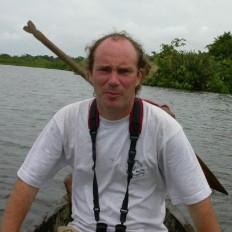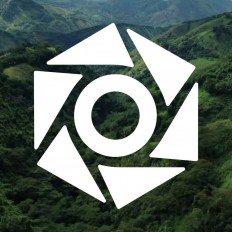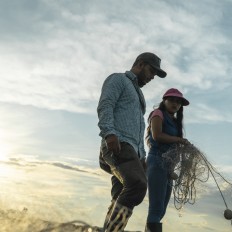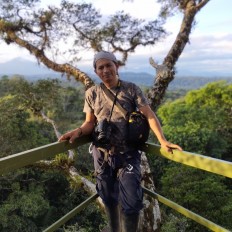Top species
- Black Tinamou (Tinamus osgoodi)
- Blue-throated Piping-Guan (Pipile cumanensis)
- Nocturnal Curassow (Nothocrax urumutum)
- Salvin's Curassow (Mitu salvini)
- Buff-tailed Sicklebill (Eutoxeres condamini)
- Pale-tailed Barbthroat (Threnetes leucurus)
- Blue-fronted Lancebill (Doryfera johannae)
- Ecuadorian Piedtail (Phlogophilus hemileucurus)
- Black-throated Brilliant (Heliodoxa schreibersii)
- Gould's Jewelfront (Heliodoxa aurescens)
- Chestnut-headed Crake (Rufirallus castaneiceps)
- Black-faced Hawk (Leucopternis melanops)
- Foothill Screech-Owl (Megascops roraimae)
- Band-bellied Owl (Pulsatrix melanota)
- Pavonine Quetzal (Pharomachrus pavoninus)
- Western Striolated-Puffbird (Nystalus obamai)
- Coppery-chested Jacamar (Galbula pastazae)
- Golden-collared Toucanet (Selenidera reinwardtii)
- White-throated Woodpecker (Piculus leucolaemus)
- Lined Forest-Falcon (Micrastur gilvicollis)
- Fulvous Antshrike (Frederickena fulva)
- Foothill Stipplethroat (Epinecrophylla spodionota)
- Banded Antbird (Dichrozona cincta)
- White-plumed Antbird (Pithys albifrons)
- Hairy-crested Antbird (Rhegmatorhina melanosticta)
- White-lored Antpitta (Myrmothera fulviventris)
- Duida Woodcreeper (Lepidocolaptes duidae)
- Green Manakin (Cryptopipo holochlora)
- Fiery-throated Fruiteater (Pipreola chlorolepidota)
- Gray-tailed Piha (Snowornis subalaris)
- Amazonian Umbrellabird (Cephalopterus ornatus)
- Foothill Schiffornis (Schiffornis aenea)
- White-browed Purpletuft (Iodopleura isabellae)
- Spectacled Bristle-Tyrant (Pogonotriccus orbitalis)
- Ecuadorian Tyrannulet (Phylloscartes gualaquizae)
- Black-and-white Tody-Flycatcher (Poecilotriccus capitalis)
- Golden-winged Tody-Flycatcher (Poecilotriccus calopterus)
- Foothill Elaenia (Myiopagis olallai)
- Yellow-lored Tanager (Chlorothraupis frenata)
- Fulvous Shrike-Tanager (Lanio fulvus)
List up to ca. 25 species that:
• have a limited distribution range and/or are rare on a global level
• are most sought-after by birdwatchers at this site
• and are relatively easy to see at this site (year-round or seasonally)
| Black Tinamou (Tinamus osgoodi) | |
| Blue-throated Piping-Guan (Pipile cumanensis) | |
| Nocturnal Curassow (Nothocrax urumutum) | |
| Salvin's Curassow (Mitu salvini) | |
| Buff-tailed Sicklebill (Eutoxeres condamini) | |
| Pale-tailed Barbthroat (Threnetes leucurus) | |
| Blue-fronted Lancebill (Doryfera johannae) | |
| Ecuadorian Piedtail (Phlogophilus hemileucurus) | |
| Black-throated Brilliant (Heliodoxa schreibersii) | |
| Gould's Jewelfront (Heliodoxa aurescens) | |
| Chestnut-headed Crake (Rufirallus castaneiceps) | |
| Black-faced Hawk (Leucopternis melanops) | |
| Foothill Screech-Owl (Megascops roraimae) | |
| Band-bellied Owl (Pulsatrix melanota) | |
| Pavonine Quetzal (Pharomachrus pavoninus) | |
| Western Striolated-Puffbird (Nystalus obamai) | |
| Coppery-chested Jacamar (Galbula pastazae) | |
| Golden-collared Toucanet (Selenidera reinwardtii) | |
| White-throated Woodpecker (Piculus leucolaemus) | |
| Lined Forest-Falcon (Micrastur gilvicollis) | |
| Fulvous Antshrike (Frederickena fulva) | |
| Foothill Stipplethroat (Epinecrophylla spodionota) | |
| Banded Antbird (Dichrozona cincta) | |
| White-plumed Antbird (Pithys albifrons) | |
| Hairy-crested Antbird (Rhegmatorhina melanosticta) | |
| White-lored Antpitta (Myrmothera fulviventris) | |
| Duida Woodcreeper (Lepidocolaptes duidae) | |
| Green Manakin (Cryptopipo holochlora) | |
| Fiery-throated Fruiteater (Pipreola chlorolepidota) | |
| Gray-tailed Piha (Snowornis subalaris) | |
| Amazonian Umbrellabird (Cephalopterus ornatus) | |
| Foothill Schiffornis (Schiffornis aenea) | |
| White-browed Purpletuft (Iodopleura isabellae) | |
| Spectacled Bristle-Tyrant (Pogonotriccus orbitalis) | |
| Ecuadorian Tyrannulet (Phylloscartes gualaquizae) | |
| Black-and-white Tody-Flycatcher (Poecilotriccus capitalis) | |
| Golden-winged Tody-Flycatcher (Poecilotriccus calopterus) | |
| Foothill Elaenia (Myiopagis olallai) | |
| Yellow-lored Tanager (Chlorothraupis frenata) | |
| Fulvous Shrike-Tanager (Lanio fulvus) |
White-plumed Antbird (Pithys albifrons) was added by Jurgen Beckers (2020-10-04 08:46:35)
Foothill Schiffornis (Schiffornis aenea) was added by Jurgen Beckers (2020-10-04 08:46:11)
Green Manakin (Cryptopipo holochlora) was added by Jurgen Beckers (2020-10-04 08:45:27)
Duida Woodcreeper (Lepidocolaptes duidae) was added by Jurgen Beckers (2020-10-04 08:45:16)
Coppery-chested Jacamar (Galbula pastazae) was added by Jurgen Beckers (2020-10-04 08:44:47)
Black-faced Hawk (Leucopternis melanops) was added by Jurgen Beckers (2020-10-04 08:44:33)
Hairy-crested Antbird (Rhegmatorhina melanosticta) was added by Jurgen Beckers (2020-10-04 08:44:21)
Western Striolated-Puffbird (Nystalus obamai) was added by Jurgen Beckers (2020-10-04 08:44:11)
Chestnut-headed Crake (Rufirallus castaneiceps) was added by Jurgen Beckers (2020-10-04 08:43:59)
Pavonine Quetzal (Pharomachrus pavoninus) was added by Jurgen Beckers (2020-10-04 08:43:44)
Black-throated Brilliant (Heliodoxa schreibersii) was added by Jurgen Beckers (2020-10-04 08:43:30)
Pale-tailed Barbthroat (Threnetes leucurus) was added by Jurgen Beckers (2020-10-04 08:43:07)
Buff-tailed Sicklebill (Eutoxeres condamini) was added by Jurgen Beckers (2020-10-04 08:42:48)
Black Tinamou (Tinamus osgoodi) was added by Jurgen Beckers (2020-10-04 08:42:37)
Salvin's Curassow (Mitu salvini) was added by Jurgen Beckers (2020-10-04 08:41:40)
Fulvous Shrike-Tanager (Lanio fulvus) was added by Mathias Ritschard (Admin) (2020-10-03 12:08:55)
Yellow-lored Tanager (Chlorothraupis frenata) was added by Mathias Ritschard (Admin) (2020-10-03 12:08:10)
Foothill Elaenia (Myiopagis olallai) was added by Mathias Ritschard (Admin) (2020-10-03 12:04:46)
Golden-winged Tody-Flycatcher (Poecilotriccus calopterus) was added by Mathias Ritschard (Admin) (2020-10-03 12:03:56)
Black-and-white Tody-Flycatcher (Poecilotriccus capitalis) was added by Mathias Ritschard (Admin) (2020-10-03 12:03:34)
Ecuadorian Tyrannulet (Phylloscartes gualaquizae) was added by Mathias Ritschard (Admin) (2020-10-03 12:03:10)
Spectacled Bristle-Tyrant (Pogonotriccus orbitalis) was added by Mathias Ritschard (Admin) (2020-10-03 12:02:52)
White-browed Purpletuft (Iodopleura isabellae) was added by Mathias Ritschard (Admin) (2020-10-03 12:02:12)
Amazonian Umbrellabird (Cephalopterus ornatus) was added by Mathias Ritschard (Admin) (2020-10-03 12:01:18)
Gray-tailed Piha (Snowornis subalaris) was added by Mathias Ritschard (Admin) (2020-10-03 12:00:54)
Fiery-throated Fruiteater (Pipreola chlorolepidota) was added by Mathias Ritschard (Admin) (2020-10-03 12:00:32)
White-lored Antpitta (Myrmothera fulviventris) was added by Mathias Ritschard (Admin) (2020-10-03 11:58:55)
Banded Antbird (Dichrozona cincta) was added by Mathias Ritschard (Admin) (2020-10-03 11:55:55)
Foothill Stipplethroat (Epinecrophylla spodionota) was added by Mathias Ritschard (Admin) (2020-10-03 11:55:11)
Fulvous Antshrike (Frederickena fulva) was added by Mathias Ritschard (Admin) (2020-10-03 11:54:07)
Lined Forest-Falcon (Micrastur gilvicollis) was added by Mathias Ritschard (Admin) (2020-10-03 11:53:35)
White-throated Woodpecker (Piculus leucolaemus) was added by Mathias Ritschard (Admin) (2020-10-03 11:53:10)
Golden-collared Toucanet (Selenidera reinwardtii) was added by Mathias Ritschard (Admin) (2020-10-03 11:52:44)
Band-bellied Owl (Pulsatrix melanota) was added by Mathias Ritschard (Admin) (2020-10-03 11:51:42)
Foothill Screech-Owl (Megascops roraimae) was added by Mathias Ritschard (Admin) (2020-10-03 11:51:22)
Gould's Jewelfront (Heliodoxa aurescens) was added by Mathias Ritschard (Admin) (2020-10-03 11:50:14)
Ecuadorian Piedtail (Phlogophilus hemileucurus) was added by Mathias Ritschard (Admin) (2020-10-03 11:49:38)
Blue-fronted Lancebill (Doryfera johannae) was added by Mathias Ritschard (Admin) (2020-10-03 11:49:23)
Blue-throated Piping-Guan (Pipile cumanensis) was added by Mathias Ritschard (Admin) (2020-10-03 11:48:51)
Nocturnal Curassow (Nothocrax urumutum) was added by Mathias Ritschard (Admin) (2020-10-03 11:47:57)





